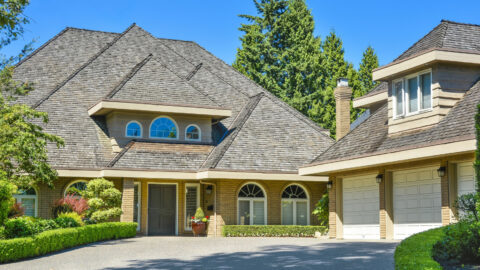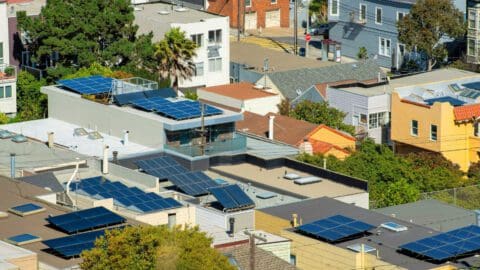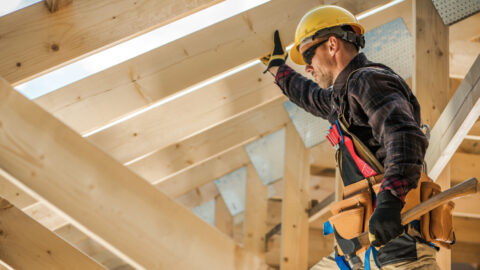Have you ever paused to observe the roofs in your vicinity? Among them, you’ll find an increasing number of structures boasting low-slope or flat roofs. These distinctive roofs, characterized by a rise of less than four inches over a 12-inch run, necessitate specialized roofing systems to stave off leaks. Regardless of whether you’re guarding an expansive commercial building or your private haven, it’s paramount to select the ideal roofing material for your low-slope or flat roof. How can this be achieved? Dive in to explore.
Why Low-Slope or Flat Roofs are Distinctive
Low-slope or flat roofs stand apart due to their unique architecture. The roofing material you choose should not only match its aesthetics but also offer robust protection against the elements. Common choices for these roofs include TPO, PVC, EPDM, Modified Bitumen (or AAP), and the more traditional Built-Up Roofing.
TPO Roofing for Low Slope or Flat Roof: A Contemporary Solution for Modern Challenges
In the world of roofing, TPO (Thermoplastic Polyolefin) stands out as a testament to innovation and functionality, particularly for low-slope or flat roofs. TPO, at its core, is a single-ply roofing membrane that has quickly gained popularity due to its array of advantageous characteristics.
Composition and Welding: One of TPO’s standout features is its unique plastic-based composition. This design choice not only ensures that the material remains lightweight but also provides an ability to weld the seams with precision. The result? A watertight seal that greatly reduces the risk of leaks, enhancing the overall lifespan of the roof.
Reflectivity and Energy Efficiency: In regions where the sun blazes with intensity, the importance of a roof that can reflect rather than absorb heat cannot be overstated. Enter the white TPO variant, which possesses high reflectivity properties. Buildings with this type of roofing can often experience a noticeable reduction in cooling costs. By reflecting the sun’s rays, it helps maintain a cooler and more comfortable interior, making it an environmentally friendly and cost-effective choice.
Durability and Resistance: Beyond its energy-saving capabilities, TPO’s resilience is noteworthy. The material is engineered to withstand a variety of challenges. Punctures, a common concern for many roofing materials, are less of a threat for TPO. Whether it’s a stray branch or other debris, TPO holds its ground commendably. Additionally, its robust structure allows it to brave moderately sized hail and other harsh weather conditions, ensuring that buildings remain protected even when Mother Nature shows her unpredictable side.
In sum, TPO roofing is not just a modern solution—it’s a holistic approach to contemporary roofing challenges. With its combination of durability, energy efficiency, and formidable resistance to external threats, TPO roofing makes a compelling case for those seeking a reliable and future-ready roofing solution.
PVC Roofs: A Legacy of Reliability and Versatility
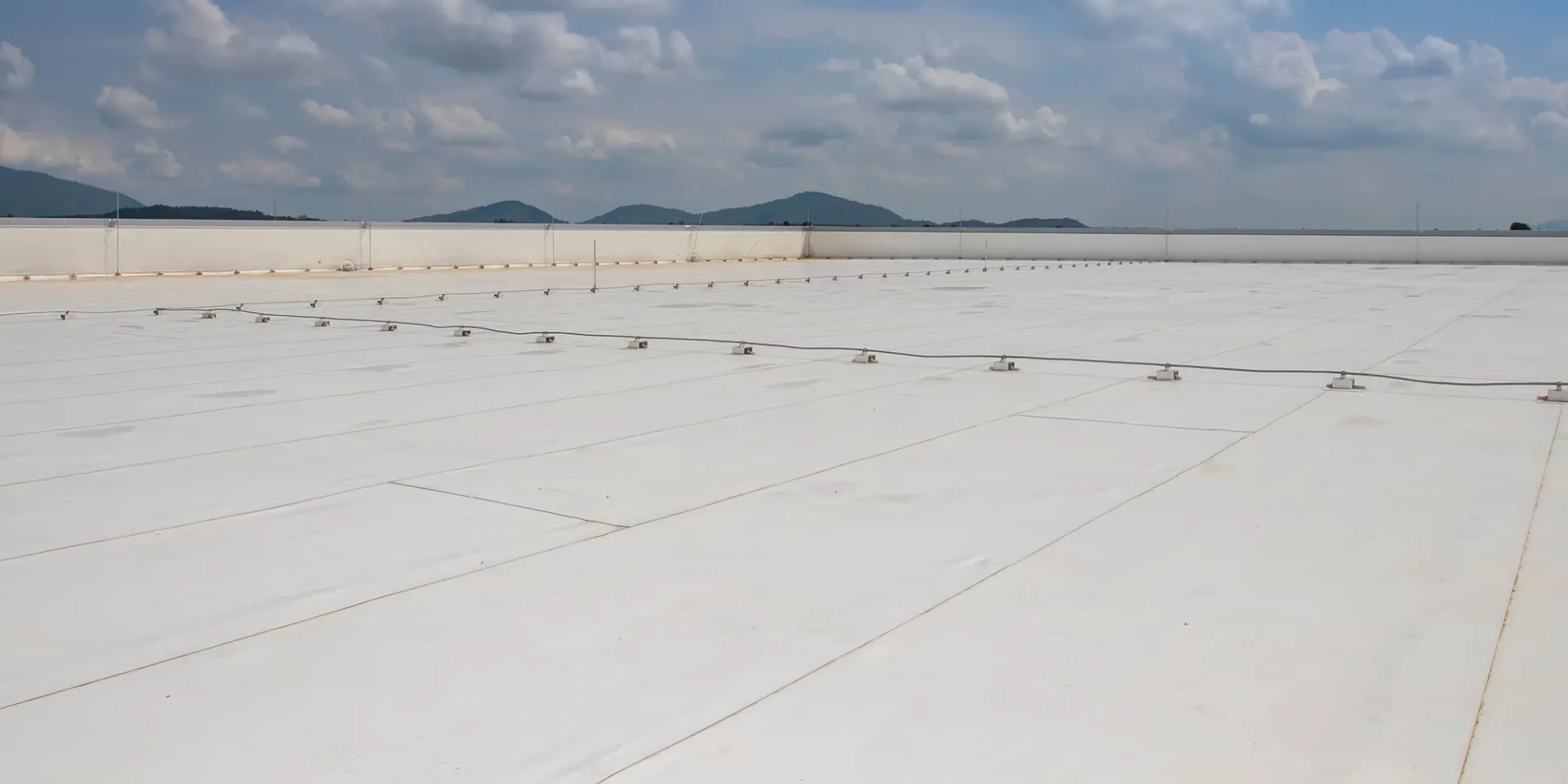
In the pantheon of roofing materials, PVC (polyvinyl chloride) holds a venerable position, especially when discussing single-ply roofing solutions for low-slope or flat structures. Its journey to this status is underpinned by a series of advantages that have ensured its continued relevance, even as newer materials emerged on the scene.
A Stalwart Before TPO: Before the advent of TPO and its subsequent rise to fame, PVC had already firmly established its presence in the roofing industry. Its tenure as a top-choice material for decades speaks volumes about its effectiveness and the trust that professionals place in it.
Flexibility Meets Durability: One of PVC’s standout features is its inherent flexibility. Unlike some other materials that might crack or deteriorate under changing weather conditions, PVC maintains its structural integrity. This flexibility not only ensures a snug fit over the contours of a building but also means it can adapt to building movements or temperature-induced expansions and contractions without compromising its protective function.
Cool-Roof Credentials: In an age where energy efficiency and sustainability are paramount, PVC’s cool-roof qualification is more relevant than ever. Its reflective properties ensure that a significant portion of the sun’s rays are bounced back, thereby reducing the heat absorbed by the building. This can lead to substantial savings in air-conditioning costs and contribute to creating a more comfortable indoor environment during hot seasons.
Guardian Against Chemicals: Perhaps one of the most distinguishing features of PVC roofing is its commendable resistance to chemicals. This trait becomes invaluable, especially in commercial settings like restaurants or industrial facilities. Vents from such establishments often emit compounds like grease or oil. A roofing material susceptible to these chemicals could deteriorate rapidly, leading to leaks or structural weaknesses. PVC stands resilient against these challenges, offering an added layer of protection and peace of mind.
Maintenance and Longevity: Another feather in PVC’s cap is the ease with which it can be maintained. Simple, routine checks and minor cleanups can ensure the roof remains in optimal condition for years. Its longevity, coupled with minimal maintenance requirements, often translates to cost savings in the long run.
In the final analysis, PVC roofing embodies a synthesis of tradition and performance. Its legacy in the roofing industry isn’t just a product of time but is cemented by its consistent ability to meet and often exceed expectations. It stands as a testament to the adage that sometimes, the old ways can indeed be the best ways.
EPDM for Low Slope or Flat Roof: A Blend of Flexibility and Longevity for Modern Roofing
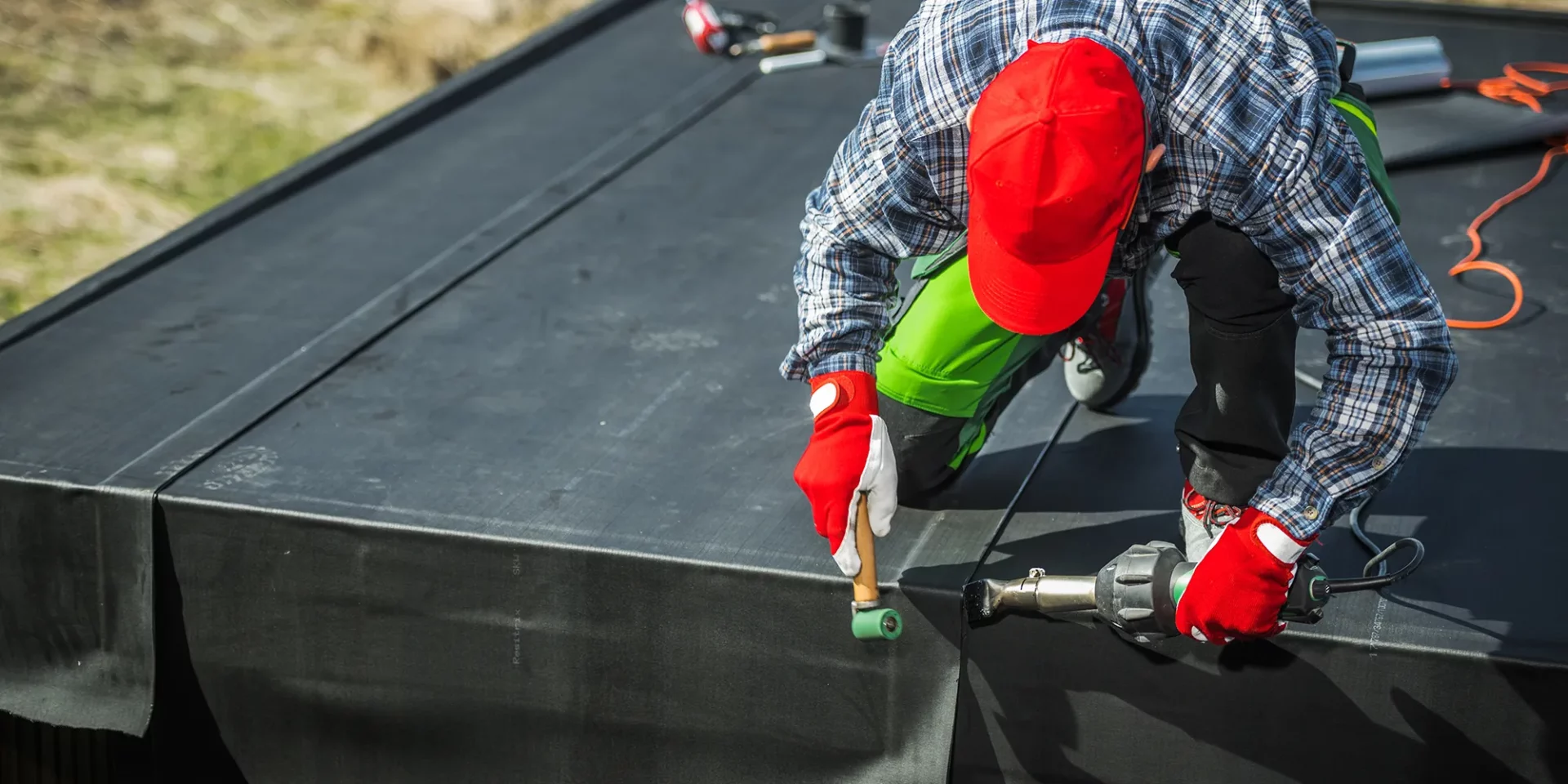
When we talk about innovative roofing solutions, Ethylene propylene diene terpolymer, more commonly known as EPDM, undeniably occupies a significant spot in the conversation, especially for those with low-slope or flat roofs. Its unique properties and benefits have paved the way for its widespread adoption.
Unrivaled Flexibility and Resilience: At the heart of EPDM’s prowess is its astounding flexibility. Unlike some roofing materials that may become brittle or degrade under extreme temperature fluctuations, EPDM retains its elastic properties. This means that whether faced with the blazing heat of summer or the biting cold of winter, this material stands steadfast, resisting cracks and tears. This adaptability ensures an extended lifespan, reducing the need for frequent repairs or replacements.
Exceptional Chemical Resistance: Beyond its inherent flexibility, EPDM boasts an impressive resistance to a wide range of chemicals. Whether it’s exposure to acid rain, alkalis, or other harsh substances, EPDM remains undeterred. This chemical resilience is especially advantageous for industrial settings or areas prone to environmental pollutants, ensuring that the roof remains uncompromised and continues to offer robust protection.
Color Choices and Aesthetic Flexibility: Traditional black EPDM has been the go-to choice for many due to its natural UV resistance. However, the introduction of white EPDM has expanded the palette, providing an aesthetically pleasing alternative that also offers excellent reflective properties. This can be particularly beneficial for buildings in sun-drenched regions, helping to keep interiors cooler and potentially saving on energy costs.
Robust Puncture Resistance: Owing to its rubbery composition, EPDM naturally fends off punctures. Everyday debris or occasional stray objects are less likely to compromise the integrity of an EPDM roof. However, it’s worth noting that while it excels in resisting standard punctures, care should be taken in areas with frequent foot traffic. The material’s vulnerability to sharp objects, like gravel trapped in shoe soles, means that regular maintenance checks are advisable to ensure maximum performance.
In conclusion, EPDM roofing emerges as more than just a flexible and durable option. It’s a comprehensive solution, addressing a wide array of challenges that modern roofs face. From temperature extremes to chemical exposures and aesthetic considerations, EPDM ensures that both form and function are impeccably catered to.
Modified Bitumen or AAP: A Budget-Conscious Choice with Distinct Advantages

Delving deep into the realm of roofing solutions, Modified Bitumen, frequently identified by its other names – atactic polypropylene (APP) or simply “mod bit” – stands as a testament to how traditional materials can be refined to meet modern requirements.
Asphalt at its Core: At the heart of modified bitumen is its foundational component – asphalt. The material’s asphaltic nature ensures it offers a blend of durability and adaptability, especially for roofs that are regularly maintained. It brings with it the tried-and-tested reliability of traditional asphalt roofing, but with enhanced benefits tailored for contemporary structures.
Cost-Effectiveness for Budgeted Projects: One of the most compelling reasons for the rising popularity of modified bitumen is its cost-effectiveness. For property owners or developers working on a tight budget, mod bit emerges as a feasible option that doesn’t compromise on essential roofing functions. This means you get a protective layer without a hefty price tag.
Versatile Installation Methods: Catering to diverse construction needs, modified bitumen can be installed in multiple ways. The ‘torch-down’ method involves heating the material during installation, ensuring a secure bond to the substrate. On the other hand, the self-adhering membranes come with a pre-applied adhesive layer, making the installation process simpler and often faster. The choice of method can be influenced by factors such as the building’s structure, climatic conditions, and budget constraints.
Water Pooling Considerations: While modified bitumen holds its own in various scenarios, it’s vital to ensure that the roof has adequate drainage. Roofs that frequently experience water pooling can accelerate wear and tear on the material. However, with proper maintenance and regular checks, these potential challenges can be effectively managed.
Longevity in Perspective: Every roofing material has a lifecycle, and while modified bitumen is undeniably cost-effective at the outset, it’s essential to consider its longevity. When compared to some high-end materials, mod bit might require replacement or maintenance a bit earlier. Nonetheless, with proactive care and timely interventions, its lifespan can be optimized, ensuring you get the most out of your investment.
In essence, Modified Bitumen or AAP embodies an intersection of affordability and functionality. For those seeking a balanced solution that takes both budget constraints and roofing efficacy into account, it’s a choice worth exploring.
Built-Up Roofing for Low Slope or Flat Roof: A Time-Honored Solution with Enduring Benefits
Built-up roofing (BUR) is more than just a roofing system; it’s a testament to the adage, “if it isn’t broken, don’t fix it.” For well over a century, it has withstood evolving architectural demands, continuing to serve as a dependable choice for countless structures.
Multilayered Defense: At its core, built-up roofing is a composite system. It employs a combination of multiple layers of reinforced felt, providing a thick barrier against potential external threats. Each layer is meticulously saturated with hot liquid asphalt, ensuring a continuous, impermeable seal against the elements. This multi-tiered structure is integral to its ability to offer unparalleled protection against leaks and water infiltration.
UV Protection with Pea Gravel: In a strategic blend of function and durability, the outermost layer of a BUR system typically incorporates pea gravel. While it certainly adds an aesthetic texture, its primary function is to serve as a UV shield. This not only extends the roof’s life by preventing direct sunlight degradation but also adds an extra layer of defense against punctures and minor impacts.
Resilience Against Hail and Other Elements: One of the unsung virtues of built-up roofing is its innate ability to withstand hail and other adverse weather conditions. The thickness and compactness of its layers offer a formidable resistance against hail impacts, reducing potential damage and subsequent repair costs. This makes BUR particularly beneficial in areas prone to hailstorms and other unpredictable weather events.
Installation Considerations: While the benefits of BUR are plenty, it’s crucial to acknowledge the intricacies of its installation process. The traditional method, which involves melting asphalt in a kettle, comes with inherent risks, especially related to fire safety. Proper safety protocols and experienced professionals are essential to mitigate these risks. When executed correctly, the end result is a seamlessly integrated and highly resilient roofing system.
Economic Viability for Large Surfaces: For vast low-slope or flat roof expanses, built-up roofing can emerge as a highly economical solution. Given its durability and relative maintenance ease over large areas, the initial investment can be offset by reduced maintenance costs and extended lifespan, often surpassing many other contemporary roofing materials.
In conclusion, built-up roofing is a legacy in the roofing industry, bridging the gap between time-tested techniques and modern-day requirements. Its longstanding reputation is not merely based on tradition but on its proven ability to consistently deliver in terms of protection, longevity, and overall value.
Seeking Expertise for Your Low-Slope or Flat Roof?
Selecting the right material for your roof can indeed be daunting. Fortunately, you need not navigate these waters alone. With over 25 years of unmatched expertise in Florida, John Hogan Roofing Company stands as a beacon for all your roofing needs, be it minor repairs or comprehensive installations. Why trust anyone but the best? Reach out today and fortify your property’s first line of defense.
Choosing the Right Covering for Your Low-Slope or Flat Roof – The Video
HAVE THE WORK COMPLETED RIGHT THE FIRST TIME
You May Also Like:
A Homeowner’s Guide to the Florida PACE Program for Roof Replacement
In Florida, a strong, reliable roof isn’t a luxury—it’s a necessity. But with the high cost of replacement, many homeowners are forced to delay this critical work, putting their homes at risk. While options like home equity loans or personal loans exist, there is another powerful financing tool designed specifically for Florida homeowners: the PACE…
Read MoreBenefits of Integrating Solar Panels with Your Roof in Florida
In the Sunshine State, it’s no secret that the sun shines bright nearly all year long. Florida is not only a paradise for beach lovers but also an ideal location for harnessing solar energy. If you’re a homeowner in Florida, you’ve probably considered integrating solar panels into your home, especially as the state continues to…
Read More15 Crucial Questions to Ask Before Hiring a Roofing Contractor in Florida
15 Crucial Questions to Ask Before Hiring a Roofing Contractor in Florida (And Why They Matter) In Florida, where hurricanes, heavy rain, and intense sunshine are part of everyday life, your roof is more than just a cover — it’s your home’s first line of defense. So, when it comes time for a roof repair…
Read More
